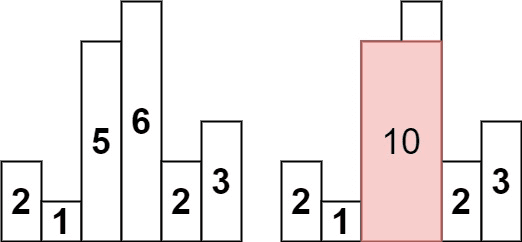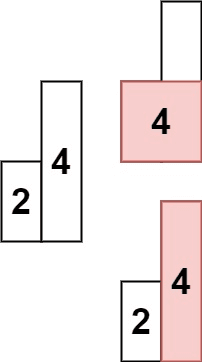67. Largest Rectangle in Histogram
Topic :
stack
Difficulty :
hard
Problem Link :
problem statement
Given an array of integers heights representing the histogram's bar height where the width of each bar is 1, return the area of the largest rectangle in the histogram.

Example 1:
Input: heights = [2,1,5,6,2,3]
Output: 10
Explanation: The above is a histogram where width of each bar is 1.
The largest rectangle is shown in the red area, which has an area = 10 units.
Example 2:
Input: heights = [2,4]
Output: 4Constraints:
1 <= heights.length <= 1050 <= heights[i] <= 104
solution
TIME COMPLEXITY : O(N)+O(N)+O(N) =O(3N)
SPACE COMPLEXITY:O(N)+O(N)+O(N) =O(3N)
import java.io.*;
import java.util.*;
class LargestRectangleInHistogram
{
public static void main(String args[]){
int []heights={2,1,5,6,2,3};
System.out.println(largestRectangleArea(heights));
}
static int largestRectangleArea(int[] heights) {
int[]previousSmallerHeights=new int[heights.length];
int[]nextSmallerHeights=new int[heights.length];
//fill the previous smaller heights array using the previous smaller concept
Stack<Integer> stack=new Stack<>();
for(int i=0;i<heights.length;i++){
while(!stack.isEmpty() && heights[stack.peek()]>=heights[i])
stack.pop();
if(stack.isEmpty())
previousSmallerHeights[i]=0;
else
previousSmallerHeights[i]=stack.peek()+1;
stack.push(i);
}
stack.clear();
//fill the next smaller heights using next smaller concept
for(int i=heights.length-1;i>=0;i--){
while(!stack.isEmpty() && heights[stack.peek()]>=heights[i])
stack.pop();
if(stack.isEmpty())
nextSmallerHeights[i]=heights.length-1;
else
nextSmallerHeights[i]=stack.peek()-1;
stack.push(i);
}
int maxArea=Integer.MIN_VALUE;
for(int i=0;i<heights.length;i++){
int left=previousSmallerHeights[i];
int right=nextSmallerHeights[i];
int area=heights[i]*(right-left+1);
maxArea=Math.max(maxArea,area);
}
return maxArea;
}
}